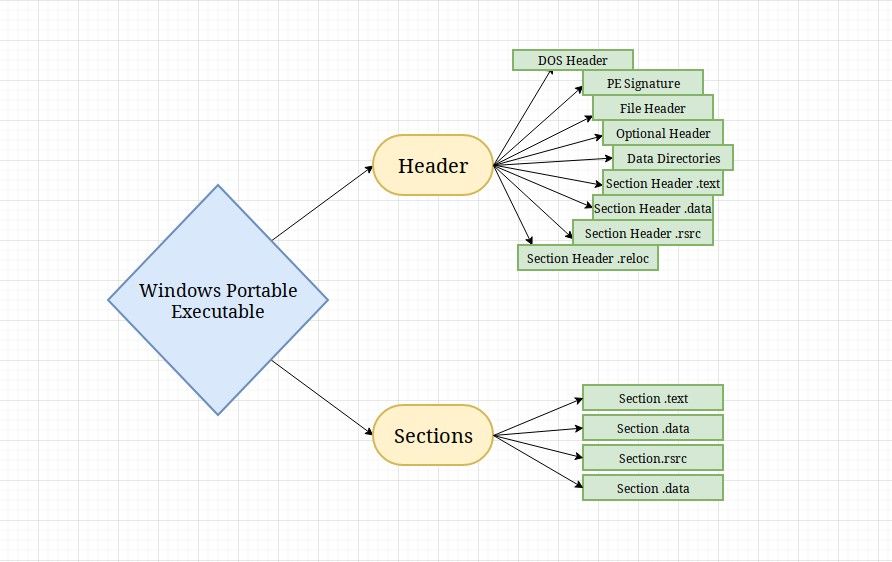
Decoding Windows Portable Executable (PE) Syntax

Decoding Windows Portable Executable (PE) Syntax
A Windows Portable Executable (PE) is the Windows native file format for executables and other binary file types. The PE file format is designed to be platform-independent, so it can be used on any Windows machine running the same operating system version and processor architecture for which the file was compiled.
So, let’s dissect the Windows PE file format, and learn about its structure and constituent components.
What Is a Windows Portable Executable File?

Before exploring the Windows Portable Executable format, it’s important to clear up the basics. Let’s take a step back and learn about the underlying concept of Windows PE—COFF.
When you compile the source code to a program, the compiler generates an object file (.obj). This object file contains instructions for the computer in binary format.
COFF or Common Object File Format is a standardized set of conventions for representing binary instructions. COFF helps in maintaining cross-platform compatibility as all COFF file formats follow the same set of rules and conventions for organizing code and data. Although COFF was originally developed for use on *NIX systems, it is now ubiquitous across all platforms.
The Windows Portable Executable (PE) file format is a modification of COFF and has been developed to be exclusively used on32-bit and 64-bit Windows systems . Unlike COFF, which provides a standardized format for object files, Windows PE provides a standardized format for executables and library files.
It contains sections and headers which provide information about the executable in question and helps the system loader manage data related to the executable. The headers in a PE file help the system loader map the file onto the memory, resolve dependencies such as API exports/imports, manage resources and prepare the file for execution.
Linux also has its own iteration of the COFF; it’s called Executable Link File or in short, ELF binary. You can check if a file is ELF or not by running thefile command on Linux with the filename as the first argument.
The Structure of a Windows Portable Executable

The Portable Executable file format consists of several components, each with a specific purpose. These components include:
- Section headers, which describe the layout and characteristics of each section of the file The sections themselves, which contain executable code, data, and resources.
- The PE header, which provides information about the file’s overall structure and requirements.
- The DOS header, which includes a small program that runs when the file is executed on a DOS system.
- And finally, the PE section headers, which describe each section’s location and attributes within the file.
Overall, these components work together to create a structured format that allows the operating system to properly load, execute, and manage the executable code contained in the file. Let’s learn exactly what each component does.
DOS Header
The first part of a PE file is called the DOS Header. A small amount of executable code is stored in the DOS header which can also be run on a DOS machine.
This code is also called the MS-DOS stub and is used to throw an error message on systems that don’t support the PE file.
PE Header
The Portable Executable header gives information about the executable, like how big the file is, where the different parts are located, and what resources the executable needs. The PE header also has information about the type of executable, whether it’s aWindows .DLL file or an .EXE.
Section Headers
Sections are implemented to organize the many components of an executable such as code, data, and resources like text strings, images, etc. The section headers include information regarding the size and location of each section, as well as any associated flags.
The flags associated with each section header can indicate various attributes of the section, such as whether it is executable, writable, or readable. These flags help the operating system to properly load and manage the contents of each section during program execution.
Sections
The sections themselves comprise the executable’s real code, data, and resources. Each segment is aligned to a certain memory boundary and has its own set of attributes that affect how the operating system handles it.
Now You Know All About the Windows Portable Executable File Format
The Windows Portable Executable is a robust and versatile file format used to produce a wide variety of Windows applications and system components. By understanding the structure of the PE file format, developers can construct efficient apps that take advantage of Windows’ distinctive characteristics.
Besides gaining an in-depth understanding of the platform your app will run on, by following a few standard good coding practices, you’ll be able to maximize the quality of the application irrespective of the platform it’s run on.
Also read:
- [New] 2024 Approved Essential Tips for YouTube Short Fixes
- [Updated] Exclusive Selection Best 5 Free Convertors for Video From GIFs
- [Updated] Exploring Advanced Techniques in Video Thumbnail Creation for 2024
- Convenient Accessibility: Incorrancing Desktop with 'This PC'
- Detailed guide of ispoofer for pogo installation On Realme Narzo 60 5G | Dr.fone
- Disable Tracking of Program Execution Start in Windows
- Ensuring Reliable Copy Functionality in Windows 11
- Fixing Communication Breakdown with ChatGPT's Plugin Services
- In 2024, Navigating Sierra Mastering iCloud Drives' Accessibility
- In 2024, Tips and Tricks for Setting Up your ZTE Blade A73 5G Phone Pattern Lock
- In 2024, Turning Off Two Factor Authentication On Apple iPhone 15? 5 Tips You Must Know
- Innovating Explore: Key Modifications in Windows 11 Filesystem
- Mastering Windows: Execute the SFC Command Correctly
- Navigating More Efficiently with Enhanced MouseClickLock Functionality
- Pro WLS 2 Usage: Cutting-Edge Practices for Windows Users
- Reimagining Images: Windows Generative Erase Mastery
- Smart Display Essential? A Comprehensive Analysis of the Chargeek 170'S Tech Features
- Title: Decoding Windows Portable Executable (PE) Syntax
- Author: David
- Created at : 2024-12-02 18:32:12
- Updated at : 2024-12-06 16:32:55
- Link: https://win11.techidaily.com/decoding-windows-portable-executable-pe-syntax/
- License: This work is licensed under CC BY-NC-SA 4.0.